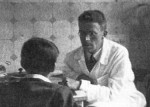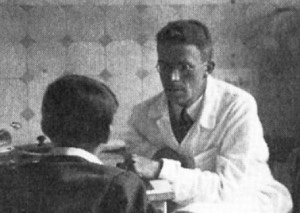
 Hans Asperger (1906-1980)
Hans Asperger (1906-1980)
The example of autism, in its form known as “Asperger’s” is a perfect illustration of how the re-naming of a pathology can influence a diagnosis’ social scope. Originally considered a symptom of schizophrenia in the early 20th century, later in 1943, Léo Kanner identified autism as a rare but rather serious child-specific pathology, marked out by social withdrawal and cognitive problems. The Asperger syndrome, thus labelled by British psychiatrist Lorna Wing in reference to Hans Asperger, professor of curative education at the University of Vienna Children's Hospital, brings into this autistic frame, children far removed from such a reductive image. For all the very real communication troubles they may present, the so-called Asperger’s can express themselves more clearly than autistic children diagnosed according to Kanner’s conceptions, indeed they often display exceptional intellectual capabilities.
The adoption in the international Diagnostic and Statistical Manual of Mental Disorders of Asperger in the 90s thus contributed to an extension of the autistic realm in our societies. It broadened the “spectrum” of this condition and advanced a more positive identification on the part of the families and individuals concerned. In keeping with the looping effect described by Ian Hacking, autism has grown its social base. In the United States, autistic incidence has gone from one child in several thousands to one in under a hundred. The redefining and renaming of the pathology have thus induced the emergence of a new social reality in regard to children with atypical relational skills.
Hans Asperger does not have much to do with this process, for he died before his name was chosen to qualify this syndrome. The first political act regarding autism was in the early 80s when British psychiatrist Lorna Wing chose, in a now famed article, to go back to this dated reference in order to describe as autistic, children who had not hitherto been thus described. The definition Wing offers of Asperger autism betokens its wide social dissemination: “All the features that characterize Asperger's syndrome can be found in varying degrees in the normal population.” Originally considered a serious and rare condition, autism changed in scale and nature, becoming a frequent and varyingly serious condition. Originally verging on incurable psychosis, autism could henceforward be presented as atypical intelligence.
Now, viewed under a second, political angle, this new diagnostic label could become popular post 2000 only because Asperger’s past was obfuscated. Hans Asperger, in his capacity as a member of the Austro-Nazi administrative and medical establishment, and along with many German and Austrian neuropsychiatrists, knowingly took part in the selection of children deemed incapable of a healthy integration in the community. Autistic children were deemed by Asperger to lack in social sentiment and were accordingly assessed by the Eugenicist project of selection and improvement of inadequate and asocial children. Thus, Hans Asperger’s diagnosis reflected the values of 3rd Reich society – no less than those of early 20th century Western neuropsychiatry. Some children deemed irredeemable were sent to institutions that organised their elimination. Between five and ten thousand children were killed in such facilities, among whom 789 in Vienna’s Spiegelgrund.
Who was this man, appointed very young, to lead a paedo-psychiatric unit? Asperger was a Catholic and never joined the Nazi party, but he joined Dollfuss’ Fatherland Front in 1934 and thus openly supported the new authoritarian government. He also belonged to anti-Semitic organisations. And yet he was also the man who, beforehand, had taken part in a form of positive Eugenics prevalent in Catholic circles, within a society increasingly concerned with young people’s education. The curative education he championed borrowed from two dimensions prevalent in inter-wars European medicine, one biological and the other spiritual, which went a long way to renew 19th century therapeutic education. Asperger was not alone in his thinking. When they gave his name in 1980 to a new form of child pathology, the European psychiatrists engaged in reviewing the autistic spectrum injected complex meaning in their decision.
Read more in the dictionary :Neurodiversity - Intelligence test - Social paediatrics
Read the paper in french :Asperger
Références :
Edith Sheffer, Les enfants d’Asperger. Le dossier noir des origines de l’autisme, Flammarion – au fil de l’histoire, trad. T. Chazal, 2019.
Lorna Wing (1981), “Asperger's Syndrome : a Clinical Account”, Psychological Medicine, 11, pp 115-129.
To quote this paper : Hervé Guillemain, "Asperger" in Hervé Guillemain, DicoPolHiS, Le Mans Université, 2021.